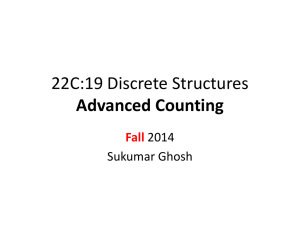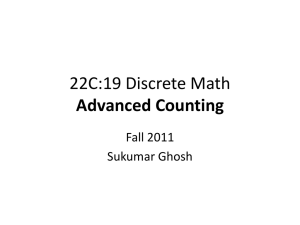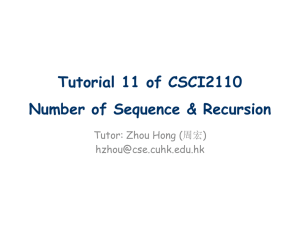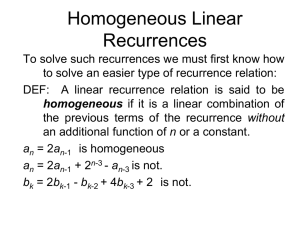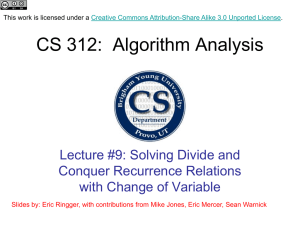Recurrence relations
advertisement
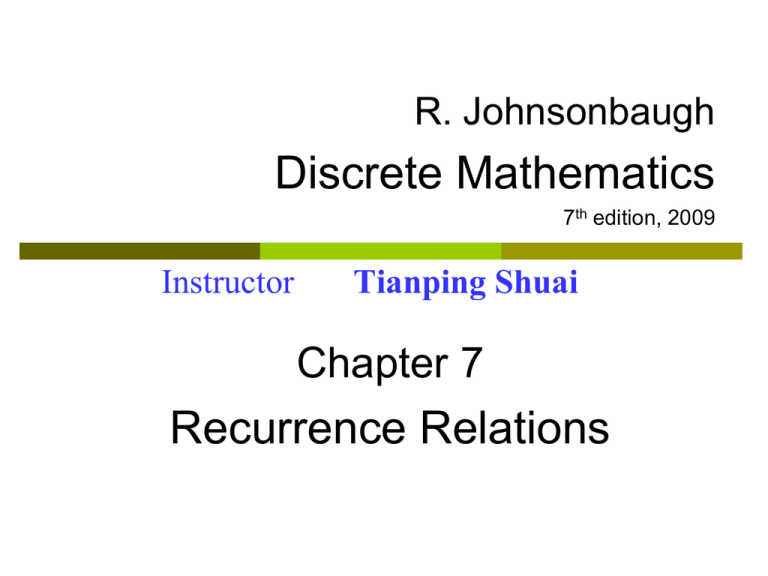
R. Johnsonbaugh
Discrete Mathematics
7th edition, 2009
Instructor
Tianping Shuai
Chapter 7
Recurrence Relations
7.1 Introduction
A recurrence relation for the sequence {an} is an
equation that expresses an is terms of one or more of the
previous terms of the sequence, namely, a0, a1, …, an-1,
for all integers n with n n0, where n0 is a nonnegative
integer.
A sequence is called a solution of a recurrence
relation if it terms satisfy the recurrence relation.
7.1 Introduction
In other words, a recurrence relation is like a
recursively defined sequence, but without specifying any
initial values (initial conditions).
Therefore, the same recurrence relation can have
(and usually has) multiple solutions.
If both the initial conditions and the recurrence
relation are specified, then the sequence is uniquely
determined.
7.1 Introduction
Example
1:
Consider the recurrence relation
an = 2an-1 – an-2 for n = 2, 3, 4, …
Is the sequence {an} with an=3n a solution of this
recurrence relation?
For n 2 we see that
2an-1 – an-2 = 2(3(n – 1)) – 3(n – 2) = 3n = an.
Therefore, {an} with an=3n is a solution of the
recurrence relation.
7.1 Introduction
Is
the sequence {an} with an=5 a solution of the same
recurrence relation?
For n 2 we see that
2an-1 – an-2 = 25 - 5 = 5 = an.
Therefore, {an} with an=5 is also a solution of the
recurrence relation.
Definition 1:A recurrence relation is an infinite
sequence a1, a2, a3,…, an,… in which the formula for
the nth term an depends on one or more preceding
terms, with a finite set of start-up values or initial
conditions
Examples of recurrence relations
Example 2:
Initial condition a0 = 1
Recursive formula: a n = 1 + 2a n-1 for n > 2
First few terms are: 1, 3, 7, 15, 31, 63, …
Example 3:
Initial conditions a0 = 1, a1 = 2
Recursive formula: a n = 3(a n-1 + a n-2) for n > 2
First few terms are: 1, 2, 9, 33, 126, 477, 1809,
6858, 26001,…
Modeling with Recurrence Relations
Example:
Someone
deposits $10,000 in a savings account at a
bank yielding 5% per year with interest compounded
annually. How much money will be in the account after
30 years?
Solution:
Let
Pn denote the amount in the account after n years.
How can we determine Pn on the basis of Pn-1?
Modeling with Recurrence Relations
We
can derive the following recurrence relation:
Pn = Pn-1 + 0.05Pn-1 = 1.05Pn-1.
The initial condition is P0 = 10,000. Then we have:
P1 = 1.05P0
P2 = 1.05P1 = (1.05)2P0
P3 = 1.05P2 = (1.05)3P0
…
Pn = 1.05Pn-1 = (1.05)nP0
We now have a formula to calculate Pn for any natural
number n and can avoid the iteration.
Modeling with Recurrence Relations
Let
us use this formula to find P30 under the initial
condition P0 = 10,000:
P30 = (1.05)3010,000 = 43,219.42
After 30 years, the account contains $43,219.42.
Algorithm
1.
2.
3.
4.
5.
Input: n
Output: the account after n years
procedure interest(n)
if n =0 then
return (1000)
return(1.05 * interest(n-1))
end interest
Compound interest
Given
P = initial amount (principal)
n = number of years
r = annual interest rate
A = amount of money at the end of n years
At the end of:
1 year:
A = P + rP
= P(1+r)
2 years:
A = P + rP(1+r) = P(1+r)2
3 years:
A = P + rP(1+r)2 = P(1+r)3
…
Obtain the formula A = P (1 + r) n
Modeling with Recurrence Relations
Another
example:
Let an denote the number of bit strings of length n that
do not have two consecutive 0s (“valid strings”). Find a
recurrence relation and give initial conditions for the
sequence {an}.
Solution:
Idea:
The number of valid strings equals the number of
valid strings ending with a 0 plus the number of valid
strings ending with a 1.
Modeling with Recurrence Relations
us assume that n 3, so that the string contains at
least 3 bits.
Let us further assume that we know the number an-1 of
valid strings of length (n – 1).
Then how many valid strings of length n are there, if the
string ends with a 1?
There are an-1 such strings, namely the set of valid strings
of length (n – 1) with a 1 appended to them.
Note: Whenever we append a 1 to a valid string, that
string remains valid.
Let
Modeling with Recurrence Relations
Now
we need to know: How many valid strings of
length n are there, if the string ends with a 0?
Valid strings of length n ending with a 0 must have a 1
as their (n – 1)st bit (otherwise they would end with 00
and would not be valid).
And what is the number of valid strings of length (n – 1)
that end with a 1?
We already know that there are an-1 strings of length n
that end with a 1.
Therefore, there are an-2 strings of length (n – 1) that end
with a 1.
Modeling with Recurrence Relations
So
there are an-2 valid strings of length n that end with
a 0 (all valid strings of length (n – 2) with 10 appended
to them).
As
we said before, the number of valid strings is the
number of valid strings ending with a 0 plus the
number of valid strings ending with a 1.
That
gives us the following recurrence relation:
an = an-1 + an-2
Modeling with Recurrence Relations
What
are the initial conditions?
a1 = 2 (0 and 1)
a2 = 3 (01, 10, and 11)
a3 = a2 + a1 = 3 + 2 = 5
a4 = a3 + a2 = 5 + 3 = 8
a5 = a4 + a3 = 8 + 5 = 13
…
This
sequence satisfies the same recurrence relation as
the Fibonacci sequence.
Since a1 = f2 and a2 = f3, we have an = fn+1.
Fibonacci sequence
Initial conditions:
f1
Recursive formula:
= 1, f2 = 2
f n+1 = f n-1 + f n for n > 3
First few terms:
n
1
2
3
4
5
6
7
8
9
10
11
fn
1
2
3
5
8
13
21
34
55
89
144
Eugene Catalan
Belgian mathematician, 1814-1894
Catalan numbers are generated by the formula:
Cn = C(2n,n) / (n+1) for n > 0
The first few Catalan numbers are:
n
0
1
2
3
4
5
6
7
8
9
10
11
Cn
1
1
2
5
14
42
132
429
1430
4862
16796
58786
Eugene Catalan
How many routes
are there from the
lower-left of n × n
square grid to the
upper-right corner
if we are restricted
to traveling only to
the right or upward
and if we are
allowed to touch
but not go above a
diagonal line from
the lower-left to the
upper-right corner?
(n,n)
(n,n)
(k,k)
(0,0) (k, k) (k,k) (n,n)
n
Cn Ck 1Cn k
k 1
Towers of Hanoi
Start with three pegs numbered 1, 2 and 3 mounted on a
board, n disks of different sizes with holes in their
centers, placed in order of increasing size from top to
bottom.
Object of the game: find the minimum number of
moves needed to have all n disks stacked in the same
order in peg number 3.
Rules of the game: Hanoi towers
Start with all disks stacked in peg 1 with the smallest at
the top and the largest at the bottom
Use peg number 2 for intermediate steps
Only a disk of smaller diameter can be placed on
top of another disk
End of game: Hanoi towers
Game ends when all disks are stacked in peg
number 3 in the same order they were stored at the
start in peg number 1.
Verify that the minimum number of moves needed
is the Catalan number C3 = 7.
Start
End
Recurrence Relation: Hanoi towers
Cn = 2 Cn-1 +1
C1 =1
We can prove that Cn = 2n -1
A problem in Economics
Demand equation: p = a - bq
Supply equation: p = kq
There is a time lag as supply reacts to changes in demand
Use discrete time intervals as n = 0, 1, 2, 3,…
Given the time delayed equations
pn = a – bqn (demand)
pn+1 = kqn+1 (supply)
The recurrence relation obtained is
pn+1 = a – bpn /k
Economic cobweb
with a stabilizing price
Ackermann’s function
Initial conditions:
A(0,n) = n + 1, for n = 0, 1, 2, 3,…
Recurrence relations:
A(m,0) = A(m – 1, 1), for m = 1, 2, 3,…
A(m,n) = A(m -1, A(m, n -1))
for m = 1, 2, 3,… and n = 1, 2, 3,…
7.2 Solving recurrence relations
In
general, we would prefer to have an explicit formula
to compute the value of an rather than conducting n
iterations.
For
one class of recurrence relations, we can obtain such
formulas in a systematic way.
7.2 Solving recurrence relations
Two main methods:
Iteration
Method for linear homogeneous recurrence relations
with constant coefficients
Method 1: Iteration
Problem: Given a recursive expression with initial
conditions a0, a1 try to express an without
dependence on previous terms.
Example: an = 2an-1 for n > 1, with initial condition
a0 = 1
Solution: an = 2n
Method 1: Iteration
a1 = 2
an = an-1 +3 n 2
an = an-1 +3 an-1 = an-2 +3
an = an-1 +3= an-2 +3 +3= an-2 + 2*3
an-2 = an-3 +3
an = an-2 + 2*3 = an-3 +3 + 2*3 = an-3 +3 *3
an = an-k + k*3
(let k=n-1)
an = a1 + (n-1)*3=2 + (n-1)*3
Method 1: Iteration
Hanoi C1 = 1
Cn = 2Cn-1 +1 n 2
Cn = 2Cn-1 +1
= 2(2Cn-2 +1)+1
= 22 Cn-2 +2+1
= 23 Cn-3 + 22 +2+1
...
= 2n-1 C1 + 2n-2 + 2n-3 + . . . + 22 +2+1
= 2n-1 + 2n-2 + 2n-3 + . . . + 22 +2+1
= 2n -1
More on the iteration method
Example: Deer Population growth
Deer population dn at time n
Initial condition: d0 = 1000
Increase from time n-1 to time n is 10%.
Therefore the recursive function is
dn – dn-1 = 0.1dn-1
dn = 1.1dn-1
Solution: dn = 1000(1.1)n
Method 2: Linear homogeneous
recurrence relations
Definition 7.2.6 A linear homogeneous recurrence
relation of order k with constant coefficients is a
recurrence relation of the form
an = c1an-1 + c2an-2 +…+ ckan-k, ck ≠0
and initial conditions
a0 = C0, a1 = C1 , … , ak-1 = Ck-1
Method 2: Linear homogeneous
recurrence relations
The recurrence relation
Sn = 2Sn-1
is linear homogeneous recurrence relation of order 1.
The recurrence relation
fn = fn-1 +fn-2
is linear homogeneous recurrence relation of order 2.
an =
3an-1 an-2
an - an-1 = 2n
an = 3n an-1
Method 2: Linear homogeneous
recurrence relations
an =
5an-1 - 6an-2
a0 = 7 a1 = 16
Order 2
Solution for order 1 is of the form sn =tn 。
for example Sn = 2Sn-1
Solution for order 2 is of the form Vn =tn ?
Method 2: Linear homogeneous
recurrence relations
Vn =tn
Vn = 5 Vn-1 - 6 Vn-2
tn = 5 tn-1 - 6 tn-2
tn - 5 tn-1 + 6 tn-2 = 0
t2 - 5 t + 6 = 0
t=2, t=3
We have two solutions
Sn = 2n Tn = 3n
Note that U n = b2n +d3n is a
solution.
To satisfy the initial conditions,
we must have
7 = U 0 = b20 +d30 =b+d
16 = U 1 = b21 +d 31 =2b+3d
b=5, d= 2
U n = 5*2n +2*3n
Method 2: Linear homogeneous
recurrence relations
Theorem 7.2.11: Given the second order linear
homogeneous recurrence relation with constant
coefficients
an = c1an-1 + c2an-2
and initial conditions a0 = C0, a1 = C1
1. If S and T are solutions then U = bS + dT is also a
solution for any real numbers b, d
2. If r is a root of t2 – c1t – c2 = 0, then the sequence
{rn}, n = 0, 1, 2,… is also a solution。
Case 1: Two different roots
3. If r1 and r2 (r1 r2) are solutions of the quadratic
equation t2 – c1t – c2 = 0, then there exist constants b
and d such that
an = br1n + dr2n
for n = 0, 1, 2, 3,…
Solving Recurrence Relations
Example:
What is the solution of the recurrence
relation an = an-1 + 2an-2 with a0 = 2 and a1 = 7 ?
Solution:
The characteristic equation of the
recurrence relation is r2 – r – 2 = 0.
Its roots are r = 2 and r = -1.
Hence, the sequence {an} is a solution to the
recurrence relation if and only if:
an = 12n + 2(-1)n for some constants 1 and 2.
Solving Recurrence Relations
the equation an = 12n + 2(-1)n and the initial
conditions a0 = 2 and a1 = 7, it follows that
a0 = 2 = 1 + 2
a1 = 7 = 12 + 2 (-1)
Solving these two equations gives us
1 = 3 and 2 = -1.
Therefore, the solution to the recurrence relation and
initial conditions is the sequence {an} with
an = 32n – (-1)n.
Given
Solving Recurrence Relations
Example:
Give an explicit formula for the Fibonacci
numbers.
Solution: The Fibonacci numbers satisfy the recurrence
relation fn = fn-1 + fn-2 with initial conditions f0 = 0 and f1 =
1.
The characteristic equation is r2 – r – 1 = 0.
Its roots are
1 5
1 5
r1
, r2
2
2
Solving Recurrence Relations
Therefore,
the Fibonacci numbers are given by
n
1 5
1 5
2
f n 1
2
2
n
some constants 1 and 2.
We can determine values for these constants so that the
sequence meets the conditions f0 = 0 and f1 = 1:
f 0 1 2 0
for
1 5
1 5
2
1
f1 1
2
2
Solving Recurrence Relations
The
unique solution to this system of two equations and
two variables is
1
1
1
, 2
5
5
So finally we obtained an explicit formula for the
Fibonacci numbers:
n
1 1 5
1 1 5
fn
5 2
5 2
n
More on linear homogeneous recurrence
relations: Case 2: One root of multiplicity 2
Theorem 7.2.14: Let an = c1an-1 + c2an-2 be a second
order linear homogeneous recurrence relation with
constant coefficients.
Let a0 = C0, a1 = C1 be the first two terms of the
sequence satisfying the recurrence relation. If r is a
root of multiplicity 2 satisfying the equation
t2 – c1t – c2 = 0,
then: there exist constants b and d such that
an = brn + dnrn
for n = 0, 1, 2, 3,…
Solving Recurrence Relations
Example:
What is the solution of the recurrence
relation an = 6an-1 – 9an-2 with a0 = 1 and a1 = 6?
Solution: The only root of r2 – 6r + 9 = 0 is r0 = 3.
Hence, the solution to the recurrence relation is
an = 13n + 2n3n for some constants 1 and 2.
To match the initial condition, we need
a0 = 1 = 1 , a1 = 6 = 13 + 23
Solving these equations yields 1 = 1 and 2 = 1.
Consequently, the overall solution is given by
an = 3n + n3n.
Solving Recurrence Relations
dn = 4(dn - 1 - dn - 2 )
d0 = d1 =1
t2 - 4t +4 = 0
r1 = r2 = r=2
dn = b 2 n+ d n 2 n
d0 = d1 =1
d0 =1= b 2 0+ d 0 2 0 = b
d1 =1= b 2 1+ d 1 2 1 = 2 b + 2 d =1
b =1, d = - ½
dn = 2 n- n 2 n-1
Solving Recurrence Relations
For the general linear homogeneous recurrence
relation of order k with constant coefficients, if r is
a root of
tk - c1 tk-1 - c2 tk-2 - . . . - ck =0
of multiplicity m, it can be shown that
rn nrn . . . nm-1rn
are solutions.
7.3 Applications to the analysis of algorithms
1. Selection sorting
This algorithm sorts the sequence
s1 , s2. . ., sn
in increasing order by first selecting the largest item
and placing it last and then recursively sorting the
remaining elements.
Selection Sorting Algorithm
1.
2.
3.
4.
5.
6.
7.
8.
9.
10.
11.
12.
13.
Input: s1 , . . ., sn and n
Output: s1 , . . ., sn arranged in increasing order
Procedure election_sort(S,n)
// basic
if n=1 then
return
// find max
max_index :=1
for i:=2 to n do
if Si > Smax_index then
max_index :=i
//move
swap(si, Smax_index)
call election_sort(S,n-1)
end election_sort
Selection Sorting Algorithm
bn ,:the number of comparisons.
The initial condition b1 =0
bn = n-1+ bn-1
Line bn
= bn-1 + n-1
1-7 : 0
= (bn-2 + n-2) + n-1
8 : n-1
= (bn-3 + n-3) + n-2 + n-1
9-11: 0
= b1 +1+2+3+ . . . +(n-1)
12: bn-1
= 0+ 1+2+3+ . . . +(n-1)
2)
=
(n-1)*n/2=
(n
b = n-1+ b
n
n-1
Review
1. Selection sorting
a) Given a sequence of n terms ak, k = 1, 2,…, n to
be arranged in increasing order
b) Count the number of comparisons bn with initial
condition b1 = 0
c) Obtain recursion relation bn = n – 1 + bn-1 for n =
1, 2, 3,…
d) bn = n(n-1)/2 = (n2)
Binary search
Input: si , si+1. . ., sj , i 1 and key, i, j
Output: sk=key, k; not found, 0
1.
Procedure binary_search(s,i,j,key)
2.
if i > j then
3.
return(0)
4.
k= (i+j)/2
5.
if key = Sk then
6.
return(k)
7.
if key< Sk then
8.
j:= k-1
9.
else
10.
i:=k+1
11.
return(binary_search(s,i,j,key))
12.
end binary_search
Binary search
Let an denote the worst-case time.
n=1, i=j, key not found, a1 =2
n>1, an =1+a n / 2
an =1+a n / 2 If n=2k , then
a2k =1+ a2k-1
Let bk =a2k , we obtain
bk = 1+ bk-1 , b0 = a1 =2
bk = 1+ bk-1 = 2+ bk-2 = . . . =k+ b0 =k+ 2
Thus, if n=2k,
an = lg n+ 2
Binary search
An arbitrary value of n falls between two powers of 2,
say
a2k -1 < an a2k
Notice that
k-1 < lgn k
We deduce
lgn < k+1= a2k-1 an a2k
=k+ 2 <3 + lgn=O(lgn)
an = (lgn)
Review
2. Binary search
Problem: Search for a value in an increasing
sequence. Return the index of the value, or 0 if
not found.
Initial condition a1 = 2
Recurrence relation an = 1 + an/2
Result: an = (lg n)
Theorem 7.3.4: The worst-case time for binary
search for input is (lgn)
7.3 Applications to the analysis of algorithms
1. Selection sorting (n2 )
2. Binary search (nlgn)
3. Merge sort (nlgn)
Merging two sequences
Problem: Combine two increasing sequences into a
single increasing sequence (merge two sequences).
Si , . . . , Sj
Si , . . . , Sm Sm+1 , . . . , Sj
m= (i+j)/2
Merging two sequences
Input: Two increasing sequences:
Si , . . . , Sm and
Sm+1 , . . . , Sj,and index i, j, m
Output: increasing sequences
ci , . . . , cj
1.
2.
3.
4.
5.
6.
7.
8.
9.
10.
11.
12.
13.
14.
15.
16.
Procedure merge(s,i,m,j,c)
// p -> Si , . . . , Sm
// q -> Sm+1 , . . . , Sj
// r -> ci , . . . , cj
p:=i
q:=m+1
r := i
//
while p <= m and q <=j do
begin
if Sp < Sq
begin
cr := Sp
p :=p+1
end
else
17.
18.
19.
20.
21.
22.
23.
24.
25.
26.
27.
28.
29.
30.
31.
32.
33.
34.
35.
36.
37.
begin
cr := Sq
q :=q+1
end
r:=r+1
end
// copy the rest elements in the 1st sequence
while p <= m do
begin
cr := Sp
p :=p+1
r:= r+1
end
// copy the rest elements in the 2nd sequence
while q <= j do
begin
cr := Sq
q :=q+1
r:= r+1
end
End merge
Merging two sequences
Theorem 7.3.7: To merge two sequences
the sum of whose lengths is n, the number
of comparisons required is n-1.
Merge sort algorithm
1.
2.
3.
4.
5.
6.
7.
8.
9.
10.
11.
12.
13.
14.
Input: Si , . . . , Sj i, j
Output: increasing sequences Si , . . . , Sj
procedure merge_sort(s, i, j)
//i=j
ifi=j then
return
//分解
m:= m= (i+j)/2
call merge_sort(s, i , m)
call merge_sort(s, m+1, j)
// merge
call merge(s,i,m,j,c)
//copy
for k:=i to j do
Sk := Ck
end merge_sort
Merge sort
12, 30, 21, 8, 6, 9, 1, 7
12 30
8 12 21 30
8 21
69
17
1679
1 6 7 8 9 12 21 30
n=2k
a2k =2a2k-1 + 2 k - 1
a2k = 2a2k-1 + 2 k - 1
= 2(2a2k-2 + 2 k-1 - 1) + 2 k - 1
= 22 a2k-2 + 2*2 k - 1-2
= 23 a2k-3 + 3*2 k - 1-2- 22
=...
=2k a20 + k*2 k - 1-2- 22 - . . .- 2k-1
= k*2 k - (2 k - 1)
= (k-1) 2 k +1
a2k -1 an a2k
k-1 < lgn k
(nlgn)=(-2+lgn)*n/2<(k-2) 2k-1 +1
=a2k -1 an a2k
k2k+1 (1+lgn)*2n +1
=O(nlgn)
an = (nlgn)
Theorem 7.3.10: The merge sort algorithm is (n lg n)
in the worst case.


